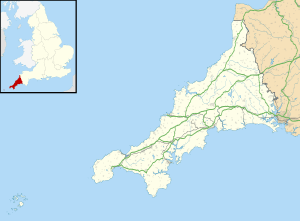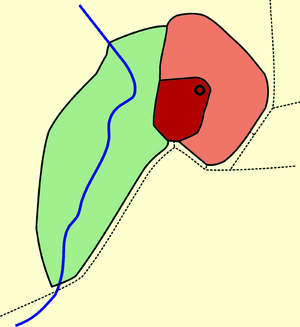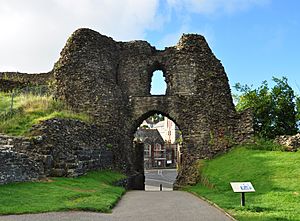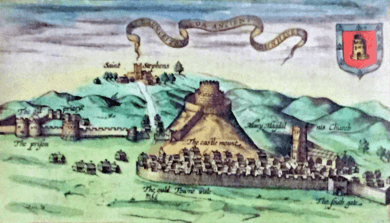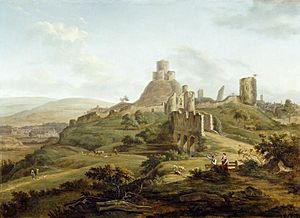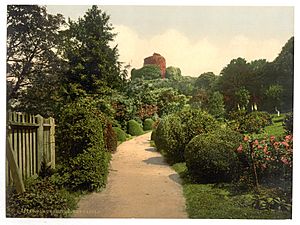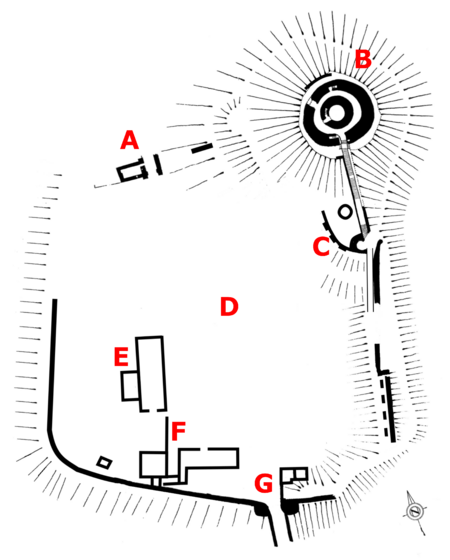Launceston Castle facts for kids
Quick facts for kids Launceston Castle |
|
|---|---|
| Launceston, Cornwall | |
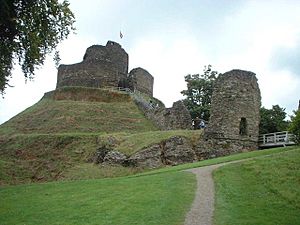
View of the motte, keep and high tower from the south-west
|
|
| Coordinates | 50°38′15″N 4°21′41″W / 50.63757°N 4.36144°W |
| Type | Castle |
| Site information | |
| Owner | Duchy of Cornwall |
| Controlled by | English Heritage |
| Condition | Ruined |
| Site history | |
| Materials | Shale |
| Events | Prayer Book Rebellion English Civil War |
Launceston Castle is an old castle in Launceston, Cornwall, England. It was likely built by Robert, the Count of Mortain, after 1068. At first, it was a simple castle made of earth and wood, with a big motte (a large mound) in one corner.
Launceston Castle became the main office for the new earldom of Cornwall. Many people lived inside its walls. In the 12th century, it was rebuilt with stone. After 1227, Richard of Cornwall made it much bigger. He added a tall tower so visitors could see his lands around the castle.
When Richard's son, Edmund, took over, he moved the main office to Lostwithiel. This made the castle less important. By 1337, the castle was falling apart. It was mostly used as a prison and for court hearings.
The castle was taken by rebels during the Prayer Book Rebellion in 1549. During the English Civil War in the 1600s, soldiers used it. Near the end of the war, people took stones from the castle to build other things. This made it hard to live in. A small prison was built in the middle of the castle yard, where punishments were carried out.
Eventually, the castle became the main prison for Cornwall. But people complained about the poor conditions for prisoners. By 1842, all prisoners had moved to Bodmin Gaol. The castle closed and was turned into a park by the Duke of Northumberland.
During the Second World War, American soldiers used the site as a hospital. Later, the Air Ministry used it for offices. The Air Ministry left in 1956, and the castle reopened to visitors. Today, the Duchy of Cornwall owns Launceston Castle. English Heritage manages it as a place for tourists to visit.
Contents
What is the History of Launceston Castle?
Early Days: 11th–12th Centuries
Launceston Castle was built after the Norman conquest of England. This was probably after the city of Exeter was captured in 1068. The castle was built in a smart spot called Dunheved. It controlled the area between Bodmin Moor and Dartmoor. It also guarded the way into Cornwall over the Polson ford.
Robert, the Count of Mortain, likely built it. William the Conqueror had given him the earldom of Cornwall. The first castle had earth and wood walls around a bailey (the main courtyard). It also had a defensive motte in its north-east corner.
The bailey had a timber hall in the south-west. Many people lived and worked in wooden buildings there. It was like a "town within a town." The castle became the main office for the earldom. Robert's court used it. There was already a market nearby. But Robert took control of it and moved it outside his new castle. He wanted to make money from the trade. A watermill was built south-west of the castle.
The first mention of the castle in old papers was in 1086. Not much is known until the 13th century. Robert's son, William, rebelled against Henry I of England in 1106. King Henry took the castle away from him. Reginald de Dunstanville held it from 1141 to 1175. Then Prince John got it in 1189. It went back to the King after John rebelled against his brother, Richard I, in 1191. King John later gave the castle to Hubert de Burgh.
A round keep (main tower) was built on the castle's motte. This was probably in the late 12th century. Two stone gatehouses and towers were also added along the walls. The wooden buildings in the bailey were rebuilt in stone. Some of these houses might have belonged to knights. These knights were given land nearby for helping to defend the castle.
How Richard of Cornwall Changed the Castle: 13th Century
Henry III's younger brother, Richard of Cornwall, received the earldom in 1227. He had a lot of money from the rich Cornish tin mining industry. He used this money to rebuild the castle's defenses. Richard did not visit Cornwall often. He mostly lived at Berkhampsted and Wallingford castles. The work at Launceston may have been to impress the Cornish nobles. Richard had a difficult relationship with them.
A small deer park was made south-west of the castle. The castle mill was inside this park. Sometimes, deer from another park were brought here. A later survey said the park was about three miles around. It could hold up to 40 deer.
Richard rebuilt the walls and gatehouses at Launceston. He built a tall tower to make the keep even higher. This was probably so guests could enjoy the view of his deer park. The old buildings in the bailey were removed. A new great hall was built in the south-west corner. People living in the castle ate well. They had many kinds of food, including deer meat. This meat likely came from the larger deer parks in the area.
A town borough was officially created in 1201. By the 1220s, a settlement grew outside the castle gates. Some people who had moved out of the bailey might have settled there. Richard built a stone wall around the new town. It connected to the castle defenses. This wall was for defense and to impress visitors.
Richard's son, Edmund, took over in 1272. He moved the main office of the earldom to Lostwithiel. This town was closer to the tin mines. Launceston Castle was still important for local government. But it soon started to be neglected. When Edmund died in 1300, he had no children. So the castle went back to the King.
From Decline to Civil War: 14th–16th Centuries
Edward II gave the earldom and Launceston Castle to his friend Piers de Gaveston. But after Gaveston's death in 1312, the castle went to Walter de Bottreaux. In 1337, Edward III's son, Edward the Black Prince, became the first Duke of Cornwall. He then owned Launceston Castle.
A survey found many problems with the castle. The walls were "ruinous" (falling apart). Various buildings inside, including two prison buildings, were "decayed." They needed new roofs. By this time, the castle's leader lived in the north gatehouse. Repairs were made in the 1340s. Edward held a council meeting at the castle in 1353. It was mostly used for court hearings and as a prison.
In the 1400s, the castle's bailey was divided by a long wall. The high tower on top of the keep became another prison. Launceston did not play a big part in the Wars of the Roses. These wars started after 1455. The castle was given to Halnatheus Malyverer in 1484. But Henry VII won the war. So Richard Edgcumbe replaced him in 1485. After Edgcumbe's death in 1489, his son Piers Edgecumbe became the leader for life.
When the historian John Leland visited in 1539, he said the castle was "the strongest" he had ever seen. But he only saw the chapel and the great hall. The hall was being used for court sessions.
Launceston Castle was important in Cornish politics in the mid-1500s. In 1548, Sir William Body was killed. He was a royal officer sent to destroy Catholic shrines. In return, 28 local men were arrested and punished at the castle. Anger grew, leading to the Prayer Book Rebellion in 1549. Sir Humphrey Arundell led the rebels. He marched through the county and took Launceston Castle that summer. It was probably taken without a fight. The castle was then used to imprison the royalist leader, Sir Richard Grenville. He died while held there. John Russell, the Earl of Bedford, later defeated the rebels. He took back Launceston and captured Arundel.
During the 16th century, the town started using the castle as a rubbish dump. Under Henry VIII, the deer park was no longer used. By 1584, the historian John Norden said the castle was "now abandoned." He noted that the hall was large, but the chapel was decaying.
From Prison to Park: 17th–18th Centuries
In 1637, the writer John Bastwick was imprisoned at Launceston Castle. People at the time said the castle was "so ruinous" that it might fall on him. Soon after, the English Civil War began. This was a fight between King Charles I's supporters and Parliament. The Royalists mostly held the castle. But Parliament's general, Sir Thomas Fairfax, finally took it in February 1646. Before leaving, the Royalist forces reportedly took the lead from the roofs. They gave the wood to the townspeople for fuel. The castle was left in such bad shape that Parliament did not bother to destroy it further.
A survey in 1650 showed that town houses had grown onto the castle's outer defenses. Only the north gatehouse could be lived in. Court hearings moved to a new hall in the town. In the same year, Parliament sold off the properties of the Duchy of Cornwall. Colonel Robert Bennett bought the castle, its deer park, and its prison. The north gatehouse began to be used as a prison. In 1656, it held members of the Society of Friends, including their founder George Fox. He called it a "nasty stinking place."
When Charles II became King again in 1660, Bennett was removed. A prison was built in the middle of the bailey in the late 1600s. It became the county prison. In 1690, the county complained to the King. They said the leader, Sir Hugh Pyper, had let it fall apart. They also said male and female prisoners were sleeping together. Two years later, the King let Hugh and his family control the castle forever. In return, Hugh agreed to spend £120 to fix the prison. The bailey was also used for carrying out punishments.
The Pyper family stopped controlling the castle in 1754. George II then appointed new leaders. They were in charge of the castle and county prison for the Duchy of Cornwall. In 1764, Coryndon Carpenter, a former mayor and castle leader, partly pulled down the north gatehouse. He used the stones to build a new house next to the castle, called Eagle House. Parts of the north-west wall were destroyed during his work. When the artist William Gilpin visited in 1775, he liked how the ruins looked.
The prison reformer John Howard reported in 1777 that the prison was very small. It had a main room and three small cages. One cage was for female prisoners. The upper room was a chapel. Food was lowered to inmates through a hole. In 1779, after complaints, Parliament gave £500. The prison was made bigger. It had a day room and seven cells for prisoners. The prison governor lived on the first floor. In return, the county agreed to take care of the prison. By 1795, Hugh Percy, the 2nd Duke of Northumberland, became an important landowner. He got the right to be the castle's leader from the Duke of Cornwall, who was then Prince George.
Modern Times: 19th–21st Centuries
In 1834, Western Road was built along the south side of the castle. This meant part of the castle wall and the fortified bridge had to be pulled down. The weak foundations caused the south-eastern tower to fall later that year. The town of Launceston became less important in the 1800s. From 1823, the county prison, known for its poor conditions, began to close. The prison at Bodmin Gaol was preferred. In 1838, the county government and courts moved to Bodmin. This town was more central in Cornwall. This led to the castle's prison closing and being torn down in 1842.
By this time, the castle was in bad shape. The bailey and earthworks were covered with pigsties, cabbage gardens, and a skittle alley for a local pub. A story says that the visiting Queen of Portugal complained about the site to Queen Victoria. This led to Hugh Percy, the 3rd Duke of Northumberland and the castle's leader, turning the area into a public park. This happened between 1840 and 1842 and cost £3,000. The south gatehouse was fixed. The remains of the north gatehouse became stables. Hugh sold his local lands in 1864. His family's control of the castle ended with the death of his brother Algernon Percy, the 4th duke, the next year. The position was empty until 1883. Then Hardinge Giffard, a local Member of Parliament, was appointed by Prince Edward.
During the later part of the Second World War, the bailey was flattened. Temporary Nissen huts were built there to form a hospital for United States Army soldiers. In 1945, the Air Ministry leased the site for offices. The Ministry of Works took over care of the castle in 1951. They pushed the Air Ministry to leave, which happened in 1956. The bailey was then covered with grass again. Archaeological excavations (digs to find old things) were done in the bailey from 1961 to 1982. They found the foundations of many medieval buildings.
Today, Launceston Castle is owned by the Duchy of Cornwall. English Heritage manages it as a tourist attraction. Around 23,000 to 25,000 people visit each year. The castle remains are protected by UK law as scheduled monuments and a grade I listed building.
What Does Launceston Castle Look Like?
Launceston Castle is built on a ridge that slopes down to the west. To the north, the ground drops to the River Kensey. The castle has a curtain wall around a bailey. There are also remains of a north and south gatehouse. The bailey, about 110 by 120 meters, has the foundations of many buildings. These include the castle's great hall. In the north-east corner is a motte, with a keep and the high tower on top. Most of the castle is built from shale stone. Details are made from granite and Polyphant stone.
You enter the castle through the 13th-century southern gatehouse. This entrance used to be protected by a 14th-century fortified bridge, also called a barbican. Only one set of stone arches remains. The south gatehouse has two round towers. They are on either side of the gateway, which was protected by a portcullis (a heavy gate). It would have had three floors. The north gatehouse on the other side of the bailey once led into the town of Launceston. The first floor was probably used by the porter. Later, the castle's leader used it, and then it became a prison.
The rectangular bailey is a courtyard, called the Castle Green. At first, earth walls protected the bailey. Later, a stone curtain wall was built around it. This wall had at least three towers. Much of the wall, including the south-eastern tower (called the Watch or Witch Tower), has been destroyed. But about 50 meters of wall still stands on the south-west side. You can see the foundations of various buildings inside the bailey. These were found during digs in the 20th century. They include the great hall, which was 22 by 7 meters. There was also a long, narrow hall, possibly a courtroom, and a large kitchen. A Victorian cottage is by the south gatehouse. It is probably where the earl's hall used to be.
The castle motte was built up in several steps. It was lower at first. Then it was made taller during the medieval period. It was reinforced in 1700 with clay. More earth was added in the late 1700s. Then it was terraced in the mid-1800s. A ditch separates the motte from the bailey. A modern bridge now crosses it. In the 13th century, a D-shaped tower protected this spot. It still stands today. The steps up to the top of the mound were once a roofed, stone corridor. The foundations of the castle well are on the west side of the causeway.
A round shell keep, 26 meters across, was built on the motte in the 12th century. It had a gateway. This was later replaced, and the current entrance is from the 13th century. The 13th-century high tower rises through the keep. It is 12 meters wide and made of dark shale. This tower replaced any rooms the shell keep might have had. Instead, it created a small, dark room at the base of the keep. The upper room of the high tower had a large window and a fireplace. It looked out over the deer park. Historians think the tower was a "private grandstand." The wall below might have been used for "lordly display" to the local community. The tower now leans a little.
The keep seems to be on the highest ground. But the actual highest point is to the south, in the deer park. Visitors would have walked around the park and by the town wall. They would go towards the south gate of the castle. This path gave great views of the keep and tower. The high tower made the castle visible to anyone coming from Devon. It stood out against the hills. The keep, park, and town walls likely showed Richard's power as earl. Some historians believe the keep and high tower also looked like Richard of Cornwall's crown. He was the King of the Romans.


